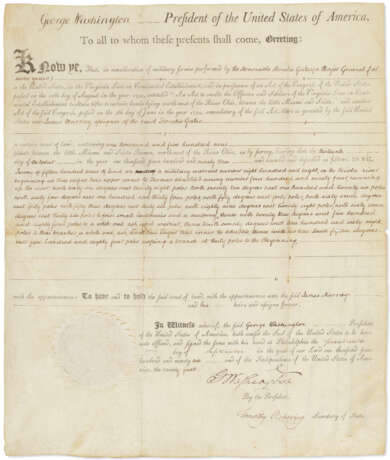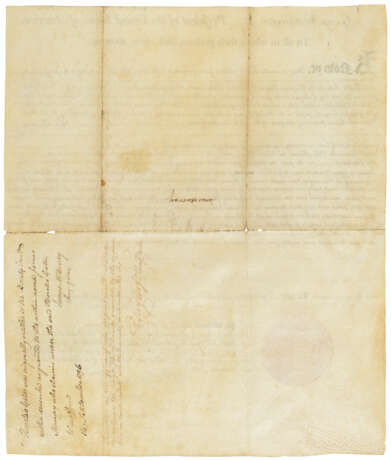ID 1362324
Lot 655 | Granting land to General Horatio Gates
Valeur estimée
$ 30 000 – 50 000
George Washington, 17 September 1796
WASHINGTON, George (1732-1799). Document signed ("G Washington") as President, Philadelphia, 17 September 1796.
One page, on vellum, 375 x 319mm, with intact paper seal at lower left (a few pin holes at fold intersections and small marginal tears, mild dustsoiling, overall quite clean). Countersigned by Timothy PICKERING ("Timothy Pickering") as Secretary of State, and bearing an autograph endorsement signed by James McHENRY ("James McHenry Secy. Of War"), 14 September 1796.
Washington issues a land grant in Ohio to Gates for his services during the American War of Independence, and in particular, "In consideration of military service performed by the Honorable Major General Horatio Gates to the United States, in the Virginia Line on the Continental Establishment, and in pursuance of an Act of the Congress of the United States … entitled, 'An Act to enable the Officers and Soldiers of the Virginia Line on Continental Establishment to obtain titles to certain land lying north-west of the River Ohio, between the little Miami and Sciota…"
Born in England, Horatio Gates obtained a commission in the British Army, seeing service in the War of the Austrian Succession and the Seven Years War. Frustrated in his inability to advance within the ranks, he sold his commission and purchased a small plantation in Virginia. Known for his administrative skills, Gates became adjutant general of the Continental Army in 1775 on Washington's recommendation, and soon afterwards, took charge of the Northern Department where he would command the forces opposing Burgoyne's southward advance from Quebec in 1777. Although he received much of the credit for the victory at Saratoga, in reality he was a timid commander, and it was the work of Stark at Bennington and Arnold's decisive action at Bemis Heights (together with Burgoyne's arrogance) that actually secured the American victory there. A significant rival to Washington, Gates sought to circumvent him by sending reports directly to Congress rather than to the commander-in-chief, and was an active participant in the movement to unseat Washington from his command (known as the Conway Cabal). Despite these slights, Washington placed Gates in command of the Southern Department in 1780, only to remove him after the disaster at the Battle of Camden the same year. In 1782 he rejoined Washington's staff, and some of his aides may have participated in the Newburgh Conspiracy, and some suspect that Gates was a covert supporter himself. (Interestingly, Pickering, one of the signatories to the present document, was also a major figure in that episode.) Following the war, Gates eventually sold his Virginia plantation, Traveler's Rest, and moved to an estate in New York called Rose Hill where he died in 1806.
The present land grant names Dr. James Murray as Gates's assignee for a tract of 1,500 acres as noted by McHenry in his endorsement, observing that Gates "was originally entitled to the Bounty land within described as granted to the within names James Murray who claims under the said Horatio Gates." Murray was Gates's son-in-law, and this was among several tracts the former general assigned to him. The land was part of what became known as the Virginia Military District, which was established in 1783 when Virginia relinquished its claim to all lands north of the Ohio River in exchange for the right to award land grants to veterans of the Virginia Line of the Continental Army. But like many of the bounty lands awarded to soldiers and officers for their service in the war, most never moved west to establish their claims, instead selling their claims to speculators. In this case, Murray subdivided the tracts awarded to him by his father-in-law and sold them to settlers for $7.25 an acre.
| Catégorie: | Services |
|---|---|
| Catégorie maison de vente aux enchères: | Lettres, documents et manuscrits, Livres et manuscrits |
| Catégorie: | Services |
|---|---|
| Catégorie maison de vente aux enchères: | Lettres, documents et manuscrits, Livres et manuscrits |
| Adresse de l'enchère |
CHRISTIE'S 20 Rockefeller Plaza 10020 New York Etats-Unis | ||||||||||||||
|---|---|---|---|---|---|---|---|---|---|---|---|---|---|---|---|
| Aperçu |
| ||||||||||||||
| Téléphone | +1 212 636 2000 | ||||||||||||||
| Fax | +1 212 636 4930 | ||||||||||||||
| Conditions d'utilisation | Conditions d'utilisation | ||||||||||||||
| transport |
Service postal Service de messagerie ramassage par vous-même | ||||||||||||||
| Modes de paiement |
Virement bancaire | ||||||||||||||
| Heures d'ouverture | Heures d'ouverture
|




